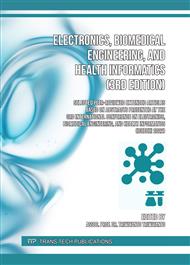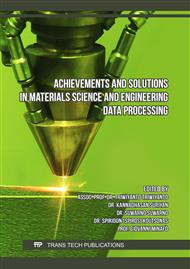[1]
E. Samei, J. T. D. Iii, J. Y. Lo, and M. P. Tornai, INVITED PAPER A FRAMEWORK FOR OPTIMISING THE RADIOGRAPHIC TECHNIQUE IN DIGITAL X-RAY IMAGING,, vol. 114, p.220–229, 2005,.
DOI: 10.1093/rpd/nch562
Google Scholar
[2]
U. Techavipoo et al., Image Quality Evaluation of a Digital Radiography System Made in Thailand,, Biomed Res. Int., vol. 2021, p.3102673, 2021,.
Google Scholar
[3]
X. Ou et al., Recent Development in X-Ray Imaging Technology: Future and Challenges,, Research, vol. 2021, p.9892152, 2021,.
Google Scholar
[4]
S. Metz et al., Chest radiography with a digital flat-panel detector: experimental receiver operating characteristic analysis.,, Radiology, vol. 234, no. 3, p.776–784, Mar. 2005,.
DOI: 10.1148/radiol.2343031805
Google Scholar
[5]
C. Martin, The importance of radiation quality for optimisation in radiology.,, Biomed. Imaging Interv. J., vol. 3, no. 2, p. e38, Apr. 2007,.
Google Scholar
[6]
A. De Hauwere, K. Bacher, P. Smeets, K. Verstraete, and H. Thierens, Analysis of image quality in digital chest imaging,, Radiat. Prot. Dosimetry, vol. 117, no. 1–3, p.174–177, 2006,.
DOI: 10.1093/rpd/nci748
Google Scholar
[7]
Azhari, Y. Hutasoit, and F. Haryanto, The influence of alteration of kvp and mas towards the image quality of acrylic using cbct,, Key Eng. Mater., vol. 829 KEM, p.252–257, 2020,.
DOI: 10.4028/www.scientific.net/kem.829.252
Google Scholar
[8]
K. H. Thunthy and L. R. Manson-Hing, Effect of mAs and kVp on resolution and on image contrast.,, Oral Surg. Oral Med. Oral Pathol., vol. 46, no. 3, p.454–461, Sep. 1978,.
DOI: 10.1016/0030-4220(78)90414-0
Google Scholar
[9]
M. B. Williams et al., Digital Radiography Image Quality: Image Acquisition,, J. Am. Coll. Radiol., vol. 4, no. 6, p.371–388, 2007,.
Google Scholar
[10]
L. T. Kawamoto, W. O. Kawamoto, A. Formigoni, E. F. Rodrigues, I. P. De Arruda Campos, and S. C. M. Rodrigues, Quality comparison of analog and digital X-ray equipment and materials in a dental clinic,, Key Eng. Mater., vol. 660, p.330–334, 2015,.
DOI: 10.4028/www.scientific.net/kem.660.330
Google Scholar
[11]
H. Aichinger, J. Dierker, S. Joite-Barfuß, and M. Säbel, Radiation Exposure and Image Quality in X-Ray Diagnostic Radiology,, Radiat. Expo. Image Qual. X-Ray Diagnostic Radiol., 2004,.
DOI: 10.1007/978-3-662-09654-3
Google Scholar
[12]
I. E. Commission, Medical electrical equipment–Exposure index of digital X-ray imaging systems-Part 1: Definitions and requirements for general radiography,, Int. Stand., p.62491–62494, (2008).
DOI: 10.3403/30156447u
Google Scholar
[13]
Q. B. Carroll, Digital Radiography in Practice. Charles C Thomas, Publisher, Limited, (2019).
Google Scholar
[14]
L. Buckley, G. Heddon, I. Byrne, and C. Angers, Improved X-Ray Safety, Quality Control, and Resource Management in Medical Imaging Using QATrack.,, J. Med. imaging Radiat. Sci., vol. 51, no. 1, p.22–28, Mar. 2020,.
DOI: 10.1016/j.jmir.2019.12.004
Google Scholar
[15]
A. Tingberg and D. Sjöström, Optimisation of image plate radiography with respect to tube voltage,, Radiat. Prot. Dosimetry, vol. 114, no. 1–3, p.286–293, 2005,.
DOI: 10.1093/rpd/nch536
Google Scholar
[16]
B. I. Reiner, Hidden costs of poor image quality: A radiologist's perspective,, J. Am. Coll. Radiol., vol. 11, no. 10, p.974–978, 2014,.
Google Scholar
[17]
B. A. Schueler, Clinical applications of basic x-ray physics principles.,, Radiogr. a Rev. Publ. Radiol. Soc. North Am. Inc, vol. 18, no. 3, p.731–44; quiz 729, 1998,.
Google Scholar
[18]
E. Vaño et al., Transition from screen-film to digital radiography: Evolution of patient radiation doses at projection radiography,, Radiology, vol. 243, no. 2, p.461–466, 2007,.
DOI: 10.1148/radiol.2432050930
Google Scholar
[19]
J. S. Jang et al., Image quality assessment with dose reduction using high kVp and additional filtration for abdominal digital radiography,, Phys. Medica, vol. 50, p.46–51, 2018, doi: https://doi.org/10.1016/j.ejmp.2018.05.007.
DOI: 10.1016/j.ejmp.2018.05.007
Google Scholar
[20]
T. M. Bernhardt et al., Diagnostic Performance of a Flat-Panel Detector at Low Tube Voltage in Chest Radiography: A Phantom Study,, Invest. Radiol., vol. 39, no. 2, p.97–103, 2004,.
DOI: 10.1097/01.rli.0000110566.23154.81
Google Scholar
[21]
T. Takaki, T. Fujibuchi, S. Murakami, T. Aoki, and M. Ohki, The clinical significance of modifying X-ray tube current-time product based on prior image deviation index for digital radiography,, Phys. Medica, vol. 63, p.35–40, 2019, doi: https://doi.org/10.1016/j.ejmp.2019.05.011.
DOI: 10.1016/j.ejmp.2019.05.011
Google Scholar
[22]
D. Mackin et al., Effect of tube current on computed tomography radiomic features,, Sci. Rep., vol. 8, no. 1, p.2354, 2018,.
Google Scholar
[23]
C. Schaefer-Prokop, U. Neitzel, H. W. Venema, M. Uffmann, and M. Prokop, Digital chest radiography: an update on modern technology, dose containment and control of image quality,, Eur. Radiol., vol. 18, no. 9, p.1818–1830, 2008,.
DOI: 10.1007/s00330-008-0948-3
Google Scholar
[24]
C. S. Moore, T. J. Wood, S. Jones, J. R. Saunderson, and A. W. Beavis, A practical method to calibrate and optimise automatic exposure control devices for computed radiography (CR) and digital radiography (DR) imaging systems using the signal-to-noise ratio (SNR) metric,, Biomed. Phys. Eng. Express, vol. 5, no. 3, 2019,.
DOI: 10.1088/2057-1976/ab123b
Google Scholar
[25]
A. Mohammed Ali, P. Hogg, M. Abuzaid, and A. England, Impact of acquisition parameters on dose and image quality optimisation in paediatric pelvis radiography—A phantom study,, Eur. J. Radiol., vol. 118, p.130–137, 2019, doi: https://doi.org/10.1016/j.ejrad.2019.07.014.
DOI: 10.1016/j.ejrad.2019.07.014
Google Scholar
[26]
A. Mohammed Ali, P. Hogg, and A. England, Dose optimisation in paediatric radiography – Using regression models to investigate the relative impact of acquisition factors on image quality and radiation dose,, Phys. Medica, vol. 68, p.61–68, 2019, doi: https://doi.org/10.1016/j.ejmp.2019.10.034.
DOI: 10.1016/j.ejmp.2019.10.034
Google Scholar
[27]
E. Sy, V. Samboju, and T. Mukhdomi, X-ray Image Production Procedures. (2022).
Google Scholar
[28]
E. K. Ofori, B. B. Ofori-Manteaw, J. N. K. Gawugah, and J. A. Nathan, Relationship between Patient Anatomical Thickness and Radiographic Exposure Factors for Selected Radiologic Examinations,, J. Heal. Med. Nurs., vol. 23, no. 0, p.150–162, 2016, [Online]. Available: https://iiste.org/Journals/index.php/JHMN/article/view/29048.
Google Scholar
[29]
J. Papp, Quality Management in the Imaging Sciences E-Book. Elsevier Health Sciences, (2018).
Google Scholar
[30]
D. Nocetti, C. Ubeda, S. Calcagno, J. Acevedo, and D. Pardo, Comparison of image quality among three X-ray systems for chest radiography: first step in optimisation.,, Radiat. Prot. Dosimetry, vol. 165, no. 1–4, p.386–391, Jul. 2015,.
DOI: 10.1093/rpd/ncv081
Google Scholar
[31]
N. E. Peacock, A. L. Steward, and P. J. Riley, An evaluation of the effect of tube potential on clinical image quality using direct digital detectors for pelvis and lumbar spine radiographs,, J. Med. Radiat. Sci., p.260–268, 2020,.
DOI: 10.1002/jmrs.403
Google Scholar
[32]
N. Gharehaghaji, D. Khezerloo, and T. Abbasiazar, Image Quality Assessment of the Digital Radiography Units in Tabriz, Iran: A Phantom Study.,, J. Med. Signals Sens., vol. 9, no. 2, p.137–142, 2019,.
DOI: 10.4103/jmss.jmss_30_18
Google Scholar
[33]
M. Arvind, Factors Affecting Image Quality For Optimal Radiodiagnosis,, Int. J. Dent. Oral Sci., p.3547–3549, Jul. 2021,.
Google Scholar
[34]
J. H. Chung et al., The Effect of a Technologist-Centered Electronic Review and Feedback System on Image Quality,, J. Am. Coll. Radiol., vol. 15, no. 10, p.1437–1442, 2018,.
Google Scholar



